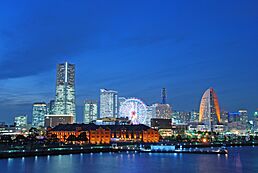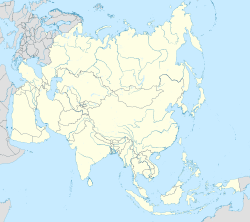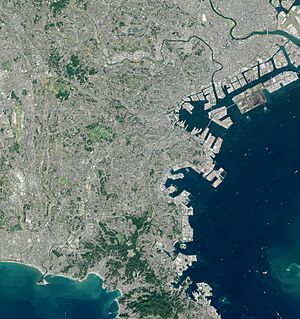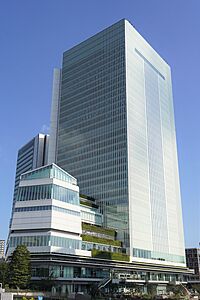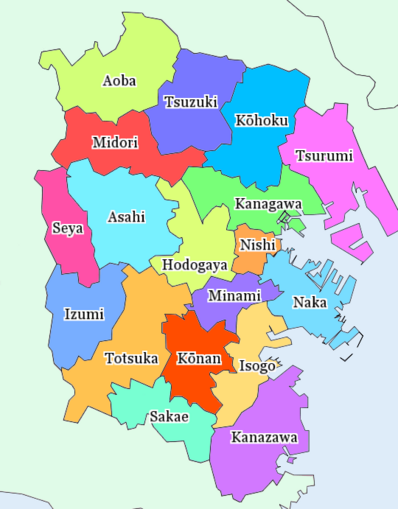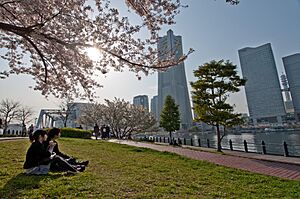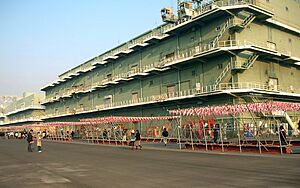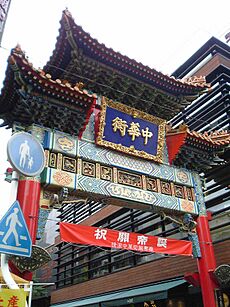Yokohama facts for kids
Quick facts for kids
Yokohama
横浜市
|
|||
|---|---|---|---|
| City of Yokohama | |||
|
Minato Mirai 21
Yokohama Chinatown
Motomachi Shopping Street
Sankei-en
Harbor View Park
Yokohama Marine Tower
Yamashita Park and Ōsanbashi Pier
|
|||
|
|||
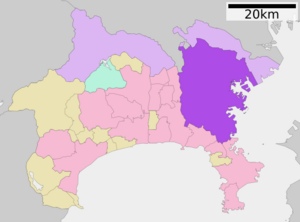
Map of Kanagawa Prefecture with Yokohama highlighted in purple
|
|||
| Country | Japan | ||
| Region | Kantō | ||
| Prefecture | Kanagawa Prefecture | ||
| Area | |||
| • Total | 437.38 km2 (168.87 sq mi) | ||
| Population
(January 1, 2023)
|
|||
| • Total | 3,769,595 | ||
| • Density | 8,606/km2 (22,290/sq mi) | ||
| Time zone | UTC+9 (Japan Standard Time) | ||
| – Tree | Camellia, Chinquapin, Sangoju Sasanqua, Ginkgo, Zelkova |
||
| – Flower | Dahlia Rose |
||
| Address | 6-50-10 Honchō, Naka-ku, Yokohama-shi, Kanagawa-ken 231-0005 |
||
| Yokohama | |||||
|---|---|---|---|---|---|

|
|||||
| Japanese name | |||||
| Kyūjitai | 橫濱 | ||||
| Shinjitai | 横浜 | ||||
|
|||||
Yokohama (Japanese: 横浜, pronounced [jokohama]) is the second-largest city in Japan. It is the biggest city in Kanagawa Prefecture. In 2023, about 3.7 million people lived here. Yokohama is located on Tokyo Bay, south of Tokyo. It is in the Kantō region on Japan's main island, Honshu. Yokohama is a major center for business, culture, and trade in the Greater Tokyo Area. It is part of the Keihin Industrial Zone.
Yokohama was one of the first cities in Japan to open for trade with Western countries in 1859. This happened after Japan ended its long period of being closed off from the world. Since then, it has been known as a global port city. Yokohama was home to many "firsts" in Japan during the Meiji period. These include the first foreign trading port and Chinatown (1859). It also had the first European-style sports fields (1860s) and an English-language newspaper (1861). The city saw the first candy and beer making (1865) and the first daily newspaper (1870). It also had the first gas street lamps (1870s), railway station (1872), and power plant (1882). Yokohama grew quickly as a major port city after Japan opened up. Today, it is one of Japan's most important ports.
Yokohama is the biggest port city and a high-tech industrial center in the Greater Tokyo Area. Many big companies have their main offices here. These include Isuzu, Nissan, JVCKenwood, Keikyu, Koei Tecmo, Sotetsu, Salesforce Japan, and Bank of Yokohama. Famous places to visit in Yokohama are Minato Mirai 21, Nippon Maru Memorial Park, Yokohama Chinatown, Motomachi Shopping Street, Yokohama Marine Tower, Yamashita Park, and Ōsanbashi Pier.
Contents
- What Does "Yokohama" Mean?
- History of Yokohama
- Geography of Yokohama
- City Views
- Population of Yokohama
- How Yokohama is Governed
- Economy of Yokohama
- Culture and Sights in Yokohama
- Sports in Yokohama
- Transportation in Yokohama
- Education in Yokohama
- Yokohama's Global Connections
- Famous People from Yokohama
- Images for kids
- See also
What Does "Yokohama" Mean?
The name Yokohama (横浜) means "horizontal beach." The area near Maita Park, the Ōoka River, and the Nakamura River used to be a bay. A sandbar separated this bay from the open sea. This sandbar was where the first Yokohama fishing village was located. Because the sandbar stuck out straight from the land, or "horizontally" when seen from the sea, it was called a "horizontal beach."
History of Yokohama
Opening the Port (1859–1868)
Before Western visitors arrived, Yokohama was a small fishing village. Japan had a rule called Sakoku, which meant it had very little contact with other countries. A big change happened in 1853–54. Commodore Matthew Perry came with American warships. He asked Japan to open its ports for trade. The Tokugawa shogunate (Japan's government at the time) agreed. They signed the Treaty of Peace and Amity.
At first, it was decided that the busy town of Kanagawa-juku would be one of the open ports. This town was on the Tōkaidō, a main road connecting Edo (now Tokyo) to Kyoto. However, the government thought Kanagawa-juku was too close to this important road. So, they built port facilities in the quiet fishing village of Yokohama instead. The Port of Yokohama officially opened on June 2, 1859.
Yokohama quickly became the main place for foreign trade in Japan. Foreigners first lived in a low-lying area called Kannai. As the city grew, they also moved to the higher Yamate district, which overlooked the city. English speakers often called this area The Bluff.
The Kannai area was for foreign trade and business. It was surrounded by a moat (a ditch filled with water). Foreign residents had special rights both inside and outside this area. Sometimes, there were problems when foreigners met local people, especially young samurai. For example, the Namamugi Incident in 1862 led to the Bombardment of Kagoshima in 1863. This event was one of the reasons the old government fell.
To protect British businesses and diplomats, a military base was set up in Yokohama in 1862. As trade grew, more Chinese people also came to live in the city. Yokohama saw many "firsts" for Japan. These included new Western styles, and photography by people like Felice Beato. Japan's first English newspaper, the Japan Herald, started in 1861. In 1865, the first ice cream and beer were made in Japan. Foreign residents also brought new sports. These included European-style horse racing in 1862, cricket in 1863, and rugby union in 1866. A big fire destroyed much of the foreign area on November 26, 1866. Smallpox was also a common health problem. But the city kept growing fast, attracting both foreigners and Japanese people.
Meiji and Taisho Periods (1868–1923)
After the Meiji Restoration in 1868, the port became very important for trading silk. Great Britain was the main trading partner. Western ideas and technology helped Japan grow. Yokohama saw Japan's first daily newspaper (1870) and first gas street lamps (1872). Japan's first railway was also built in 1872. It connected Yokohama to Shinagawa and Shinbashi in Tokyo. In 1872, Jules Verne wrote about Yokohama in his famous book Around the World in Eighty Days. He described the fast-growing, international Japanese city, even though he had never visited it.
In 1887, a British merchant named Samuel Cocking built the city's first power plant. It was first for his own use. Later, this coal power plant became the start of the Yokohama Cooperative Electric Light Company. Yokohama officially became a city on April 1, 1889. By 1899, special foreign areas were no longer separate. Yokohama was then the most international city in Japan. Foreigner areas stretched from Kannai to the Bluff area and the large Yokohama Chinatown.
The early 1900s saw a quick growth in industry. Business owners built factories on land reclaimed from the sea. This land was north of the city, towards Kawasaki. This area grew into the Keihin Industrial Area. The growth of Japanese industry brought wealth. Many rich trading families built large homes there. Also, many people moved in from Japan and Korea. This led to the creation of Kojiki-Yato, which was then Japan's largest slum.
Great Kantō Earthquake and World War II (1923–1945)
On September 1, 1923, much of Yokohama was destroyed by the Great Kantō earthquake. The Yokohama police reported that 30,771 people died and 47,908 were hurt. Before the earthquake, the city had 434,170 people. The broken pieces from the earthquake were used to create new land for parks. The most famous of these is Yamashita Park on the waterfront, which opened in 1930.
Yokohama was rebuilt, but it was destroyed again by U.S. air raids during World War II. The first bombing was on April 18, 1942, during the Doolittle Raid. On May 29, 1945, about 7,000–8,000 people were killed in one morning. This event is known as the Great Yokohama Air Raid. B-29 planes dropped firebombs on the city. In just one hour and nine minutes, 42% of the city was turned to rubble.
Postwar Growth and Development
During the American occupation after the war, Yokohama was a main base for American supplies and soldiers. This was especially true during the Korean War. After the occupation, most U.S. naval activities moved from Yokohama to a base in nearby Yokosuka.
Four years after the Treaty of San Francisco was signed, Yokohama became a designated city on September 1, 1956. This means it has many powers that usually belong to prefectural governments. The city's tram and trolleybus system was stopped in 1972. In the same year, the first line of the Yokohama Municipal Subway opened.
Construction of Minato Mirai 21 ("Port Future 21") began in 1983. This was a huge city development project on reclaimed land. It was sometimes called the "Philadelphia and Boston of the Orient." In 1989, Minato Mirai 21 hosted the Yokohama Exotic Showcase. This event showed the first public use of maglev trains in Japan. It also saw the opening of Cosmo Clock 21, which was then the tallest Ferris wheel in the world. The 860-metre-long (2,820 ft) Yokohama Bay Bridge also opened that year. In 1993, the Yokohama Landmark Tower opened in Minato Mirai 21. It is the second-tallest building in Japan.
The 2002 FIFA World Cup final was held in June at the International Stadium Yokohama. In 2009, the city celebrated 150 years since its port opened. It also marked 120 years since the City Administration began. As part of the celebration, Yokohama hosted the Fourth Tokyo International Conference on African Development (TICAD IV) in May 2008. In November 2010, Yokohama hosted the Asia-Pacific Economic Cooperation (APEC) meeting.
Geography of Yokohama
Land and Location
Yokohama covers an area of 437.38 km2 (168.87 sq mi). It is about 5 metres (16 ft) above sea level. It is the capital of Kanagawa Prefecture. To the east, it borders Tokyo Bay. The city is in the middle of the Kantō plain. Hills and mountains surround Yokohama. This has limited its growth, so the city has had to create more land from the sea. This also means Yokohama has a very high population density. About 8,500 people live per square kilometer.
The highest points in the city are Omaruyama (156 m [512 ft]) and Mount Enkaizan (153 m [502 ft]). The main river is the Tsurumi River. It starts in the Tama Hills and flows into the Pacific Ocean.
Yokohama is surrounded by other cities. These include Kawasaki, Yokosuka, Zushi, Kamakura, Fujisawa, Yamato, and Machida.
Earthquakes and Weather
Japan's island of Honshū has a lot of earthquake activity. This is because it is in the middle of the Pacific Ring of Fire. So, Yokohama is very likely to experience natural events like earthquakes and tropical cyclones.
Most earthquakes are small and people usually don't feel them. However, Yokohama has had two very big earthquakes. The 1923 Great Kantō earthquake destroyed the city. It caused over 100,000 deaths across the region. The 2011 Tōhoku earthquake and tsunami had its center on the east coast. Yokohama felt this earthquake, but there was only property damage. This is because most buildings were already built to withstand strong tremors.
Yokohama has a humid subtropical climate (Köppen: Cfa). This means it has hot, humid summers and cool winters. The weather often brings rain, clouds, and sun. However, winters are surprisingly sunny. Winter temperatures rarely go below freezing. Summers can feel very warm because of the humidity. The coldest temperature ever recorded was -8.2°C (17.2°F) on January 24, 1927. The hottest day was 37.4°C (99.3°F) on August 11, 2013. The most rain in one month was in October 2004, with 761.5 millimetres (30.0 in).
| Climate data for Yokohama (1991−2020 normals, extremes 1896−present) | |||||||||||||
|---|---|---|---|---|---|---|---|---|---|---|---|---|---|
| Month | Jan | Feb | Mar | Apr | May | Jun | Jul | Aug | Sep | Oct | Nov | Dec | Year |
| Record high °C (°F) | 20.8 (69.4) |
24.8 (76.6) |
24.5 (76.1) |
28.7 (83.7) |
31.3 (88.3) |
36.1 (97.0) |
37.2 (99.0) |
37.4 (99.3) |
36.2 (97.2) |
32.4 (90.3) |
26.2 (79.2) |
23.7 (74.7) |
37.4 (99.3) |
| Mean daily maximum °C (°F) | 10.2 (50.4) |
10.8 (51.4) |
14.0 (57.2) |
18.9 (66.0) |
23.1 (73.6) |
25.5 (77.9) |
29.4 (84.9) |
31.0 (87.8) |
27.3 (81.1) |
22.0 (71.6) |
17.1 (62.8) |
12.5 (54.5) |
20.2 (68.4) |
| Daily mean °C (°F) | 6.1 (43.0) |
6.7 (44.1) |
9.7 (49.5) |
14.5 (58.1) |
18.8 (65.8) |
21.8 (71.2) |
25.6 (78.1) |
27.0 (80.6) |
23.7 (74.7) |
18.5 (65.3) |
13.4 (56.1) |
8.7 (47.7) |
16.2 (61.2) |
| Mean daily minimum °C (°F) | 2.7 (36.9) |
3.1 (37.6) |
6.0 (42.8) |
10.7 (51.3) |
15.5 (59.9) |
19.1 (66.4) |
22.9 (73.2) |
24.3 (75.7) |
21.0 (69.8) |
15.7 (60.3) |
10.1 (50.2) |
5.2 (41.4) |
13.0 (55.4) |
| Record low °C (°F) | −8.2 (17.2) |
−6.8 (19.8) |
−4.6 (23.7) |
−0.5 (31.1) |
3.6 (38.5) |
9.2 (48.6) |
13.3 (55.9) |
15.5 (59.9) |
11.2 (52.2) |
2.2 (36.0) |
−2.4 (27.7) |
−5.6 (21.9) |
−8.2 (17.2) |
| Average precipitation mm (inches) | 64.7 (2.55) |
64.7 (2.55) |
139.5 (5.49) |
143.1 (5.63) |
152.6 (6.01) |
188.8 (7.43) |
182.5 (7.19) |
139.0 (5.47) |
241.5 (9.51) |
240.4 (9.46) |
107.6 (4.24) |
66.4 (2.61) |
1,730.8 (68.14) |
| Average snowfall cm (inches) | 4 (1.6) |
4 (1.6) |
0 (0) |
0 (0) |
0 (0) |
0 (0) |
0 (0) |
0 (0) |
0 (0) |
0 (0) |
0 (0) |
0 (0) |
9 (3.5) |
| Average precipitation days (≥ 0.5 mm) | 5.7 | 6.3 | 11.0 | 10.7 | 11.1 | 13.5 | 12.0 | 8.8 | 12.7 | 12.1 | 8.6 | 6.2 | 118.8 |
| Average relative humidity (%) | 53 | 54 | 60 | 65 | 70 | 78 | 78 | 76 | 76 | 71 | 65 | 57 | 67 |
| Mean monthly sunshine hours | 192.7 | 167.2 | 168.8 | 181.2 | 187.4 | 135.9 | 170.9 | 206.4 | 141.2 | 137.3 | 151.1 | 178.1 | 2,018.3 |
| Source: Japan Meteorological Agency | |||||||||||||
City Views
Population of Yokohama
| Historical population | ||
|---|---|---|
| Year | Pop. | ±% |
| 1870 | 64,602 | — |
| 1880 | 72,630 | +12.4% |
| 1890 | 132,627 | +82.6% |
| 1900 | 196,653 | +48.3% |
| 1910 | 403,303 | +105.1% |
| 1920 | 422,942 | +4.9% |
| 1930 | 620,306 | +46.7% |
| 1940 | 968,091 | +56.1% |
| 1950 | 951,188 | −1.7% |
| 1960 | 1,375,710 | +44.6% |
| 1970 | 2,238,264 | +62.7% |
| 1980 | 2,773,674 | +23.9% |
| 1990 | 3,220,331 | +16.1% |
| 2000 | 3,426,651 | +6.4% |
| 2010 | 3,688,773 | +7.6% |
| 2020 | 3,777,491 | +2.4% |
As of June 2024, Yokohama has 3,772,726 people. This makes it the second-most populated city in Japan, after Tokyo's 23 special wards. Yokohama has 18 wards. The most populated ward is Kohoku, with 364,760 people. Next are Aoba (308,379), Tsurumi (297,230), and Totsuka (282,601).
When it comes to how many people live in a small area, Nishi and Minami are the most crowded. They have over 15,000 people per square kilometer. Many people who live in Yokohama (1,548,077 in 2024) work outside the city, mostly in Tokyo. Also, 1,226,618 workers come into Yokohama from other cities. This means some parts of Yokohama are "bed towns" where people live but travel to other cities for work.
People from Other Countries
As of June 2024, Yokohama has 121,042 foreign residents. This is 3.2% of the total population. This number has grown a lot recently. The top three countries with many citizens living in Yokohama are all in Asia: China, South Korea, and Vietnam. Each has over 10,000 citizens here. Other countries with many residents include Brazil (2,823), the United States (2,793), Peru (1,312), the United Kingdom (840), and Germany (770). These numbers include foreign nationals born outside their home country.
How Yokohama is Governed
City Government
Yokohama is one of Japan's 20 designated cities. This means the city has many powers that usually belong to the government of a prefecture. The city is divided into wards, which also have administrative jobs. Yokohama city has 18 wards. Its main government office is in Naka Ward.
The Yokohama City Council has 86 members. They are elected from the 18 wards. The LDP has the most seats, with 36. The current mayor is Takeharu Yamanaka. He won against the previous mayor, Fumiko Hayashi, in the 2021 Yokohama mayoral election.
Yokohama's Wards
Yokohama has 18 wards (called ku in Japanese):
| Wards of Yokohama | ||||||
|---|---|---|---|---|---|---|
| Place Name | Map of Yokohama | |||||
| Rōmaji | Kanji | Population | Land area in km2 | Pop. density
per km2 |
||
| 1 | Aoba-ku | 青葉区 | 302,643 | 35.14 | 8,610 | |
| 2 | Asahi-ku | 旭区 | 249,045 | 32.77 | 7,600 | |
| 3 | Hodogaya-ku | 保土ヶ谷区 | 205,887 | 21.81 | 9,400 | |
| 4 | Isogo-ku | 磯子区 | 163,406 | 19.17 | 8,520 | |
| 5 | Izumi-ku | 泉区 | 155,674 | 23.51 | 6,620 | |
| 6 | Kanagawa-ku | 神奈川区 | 230,401 | 23.88 | 9,650 | |
| 7 | Kanazawa-ku | 金沢区 | 209,565 | 31.01 | 6,760 | |
| 8 | Kōhoku-ku | 港北区 | 332,488 | 31.40 | 10,588 | |
| 9 | Kōnan-ku | 港南区 | 221,536 | 19.87 | 11,500 | |
| 10 | Midori-ku | 緑区 | 176,038 | 25.42 | 6,900 | |
| 11 | Minami-ku | 南区 | 197,019 | 12.67 | 15,500 | |
| 12 | Naka-ku (administrative center) | 中区 | 146,563 | 20.86 | 7,030 | |
| 13 | Nishi-ku | 西区 | 93,210 | 7.04 | 13,210 | |
| 14 | Sakae-ku | 栄区 | 124,845 | 18.55 | 6,750 | |
| 15 | Seya-ku | 瀬谷区 | 126,839 | 17.11 | 7,390 | |
| 16 | Totsuka-ku | 戸塚区 | 274,783 | 35.70 | 7,697 | |
| 17 | Tsurumi-ku | 鶴見区 | 270,433 | 33.23 | 8,140 | |
| 18 | Tsuzuki-ku | 都筑区 | 211,455 | 27.93 | 7,535 | |
Economy of Yokohama
In 2020, Yokohama's total economic output was 14.06 trillion yen, or about US$133 billion. This was a small decrease from the year before because of the COVID-19 pandemic. This means each citizen's share was about US$35,107, which is a bit lower than the national average.
A large number of Yokohama's citizens (693,064 in 2020) work outside the city, mainly in Tokyo. The money they earn outside the city does not count towards Yokohama's own economic numbers. The biggest parts of Yokohama's economy are:
- Wholesale and retail (17.8%)
- Healthcare (11.7%)
- Academic, professional, or technological services (11.0%)
Major Companies in Yokohama
Many important companies have their main offices in Yokohama:
- Nissan Global Headquarters in Nishi-ku
- JVCKenwood headquarters in Kanagawa-ku
- Koei Tecmo headquarters in Kōhoku-ku
- Keikyu Group headquarters in Nishi-ku
- Sotetsu headquarters in Nishi-ku
- Isuzu headquarters in Nishi-ku
Culture and Sights in Yokohama
Yokohama has many interesting cultural places and tourist sights:
- Yokohama Chinatown
- Yokohama Three Towers
- Yamashita Park (by the harbor)
- Harbor View Park
- The Hikawa Maru, a historic passenger and cargo ship
- Yokohama Marine Tower
- Yokohama Triennale (an art festival)
- Minato Mirai 21
- Landmark Tower, 296 meters high, one of Japan's tallest buildings
- Nippon Maru, a museum ship
- Yokohama Stadium (home field for the Yokohama DeNA BayStars Pro baseball team)
- Yokohama Foreign Cemetery
- Sankei-en Garden
- Kishine-Park
- Kanazawa Bunko, a place that keeps the cultural history of the Hōjō family
- Zō-no-Hana Terrace
- Gumyōji, the oldest temple in the city
Museums to Visit
There are 42 museums in Yokohama, including:
- CupNoodles Museum (Momofuku Andō Instant Ramen Museum): This museum has many interactive exhibits. You can learn about how Japanese instant noodle soup was invented. You can even try different noodle soups.
- Kanagawa Prefectural Museum of Cultural History: Located in the old Yokohama Specie Bank building.
- Kanazawa Bunko: Shows traditional Japanese and Chinese art. Many pieces are from the Kamakura period.
- Matsuri Museum: This museum is all about the shrine festivals (Japanese Matsuri) that happen in Yokohama.
- Silk Museum: Shows how silk is made and processed. It also has many silk clothes.
- Yokohama Archives of History: Located in the former British Consulate building. It has exhibits about the port's development and the arrival of Matthew Perry.
- Yokohama Museum of Art: Opened in 1989. It shows modern art by famous international and Japanese artists.
Fun Places to Visit
In 2016, over 46 million tourists visited Yokohama. About 13% of them stayed overnight.
- Kodomo no Kuni: This means "Children's country." It's a great place for families to spend a fun day. There's lots of space to walk and play. It also has a petting zoo.
- Nogeyama Zoo: This is one of the few zoos that doesn't charge an entrance fee. It has many animals and a petting zoo where kids can play with small animals.
- Zoorasia: A nice zoo with many play areas for children. This zoo does charge an entrance fee.
- Yokohama Hakkeijima Sea Paradise: A large park with an aquarium. It also has rides, shops, and restaurants.
- Giant Gundam Robot: Since 2020, a huge robot named Gundam has been watching over the port area. It is 18 meters (59 feet) tall and weighs 25 tons. This robot is based on a science fiction TV series. It can move and even kneel down. You can even go into a cockpit inside it!
- Kamonyama Park
Sports in Yokohama
- Baseball: Yokohama DeNA BayStars
- Association football (Soccer): Yokohama F. Marinos (J1 League), Yokohama FC (J2 League), YSCC Yokohama (J3 League), NHK Yokohama FC Seagulls (Nadeshiko League Div.2)
- Velodrome: Kagetsu-en Velodrome
- Basketball: Yokohama B-Corsairs
- Rugby Union: Yokohama Eagles
- Tennis: Ai Sugiyama
- American football: Yokohama Harbors
Transportation in Yokohama

Yokohama is served by the Tōkaidō Shinkansen, which is a high-speed train line. It has a stop at Shin-Yokohama Station. Yokohama Station is also a very busy station, with two million passengers every day. The Yokohama Municipal Subway, Minatomirai Line, and Kanazawa Seaside Line provide train services within the city.
Air Travel
Yokohama does not have its own airport. However, it is close to Tokyo's two main airports. Haneda Airport is 17.4 km (10.8 miles) away. Narita International Airport is 77 km (48 miles) away.
Sea Travel
Yokohama is the 31st largest seaport in the world for total cargo volume. In 2011, it handled 121,326 freight tons. It is ranked 37th for the number of shipping containers (TEUs).
In 2013, the APM Terminals facility in Yokohama was named the most productive container terminal in the world. It averaged 163 crane moves per hour for each ship.
Train Stations
Here are some of the train lines and stations in Yokohama:
- ■ East Japan Railway Company (JR East)
- ■ Tōkaidō Main Line
- – Yokohama – Totsuka –
- ■ Yokosuka Line
- – Yokohama – Hodogaya – Higashi-Totsuka – Totsuka –
- ■ Keihin-Tōhoku Line
- – Tsurumi – Shin-Koyasu – Higashi-Kanagawa – Yokohama
- ■ Negishi Line
- Yokohama – Sakuragichō – Kannai – Ishikawachō – Yamate – Negishi – Isogo – Shin-Sugita – Yōkōdai – Kōnandai – Hongōdai –
- ■ Yokohama Line
- Higashi-Kanagawa – Ōguchi – Kikuna – Shin-Yokohama – Kozukue – Kamoi – Nakayama – Tōkaichiba – Nagatsuta –
- ■ Nambu Line
- – Yakō –
- ■ Tsurumi Line
- Main Line : Tsurumi – Kokudō – Tsurumi-Ono – Bentembashi – Asano – Anzen –
- Umi-Shibaura Branch : Asano – Shin-Shibaura – Umi-Shibaura
- ■ Central Japan Railway Company (JR Central)
- ■ Tōkaidō Shinkansen
- – Shin-Yokohama –
- ■ Keikyu
- ■ Keikyu Main Line
- – Tsurumi-Ichiba – Keikyū Tsurumi – Kagetsuen-mae – Namamugi – Keikyū Shin-Koyasu – Koyasu – Kanagawa-Shinmachi – Naka-Kido – Kanagawa – Yokohama – Tobe – Hinodechō – Koganechō – Minami-Ōta – Idogaya – Gumyōji – Kami-Ōoka – Byōbugaura – Sugita – Keikyū Tomioka – Nōkendai – Kanazawa-Bunko – Kanazawa-Hakkei –
- ■ Keikyu Zushi Line
- Kanazawa-Hakkei – Mutsuura –
- ■ Tokyu Railways
- ■ Tōyoko Line
- – Hiyoshi – Tsunashima – Ōkurayama – Kikuna – Myōrenji – Hakuraku – Higashi-Hakuraku – Tammachi – Yokohama
- ■ Meguro Line
- – Hiyoshi
- ■ Den-en-toshi Line
- – Tama-Plaza – Azamino – Eda – Ichigao – Fujigaoka – Aobadai – Tana – Nagatsuta –
- ■ Kodomonokuni Line
- Nagatsuta – Onda – Kodomonokuni
- ■ Sagami Railway
- ■ Sagami Railway Main Line
- Yokohama – Hiranumabashi – Nishi-Yokohama – Tennōchō – Hoshikawa – Wadamachi – Kamihoshikawa – Nishiya – Tsurugamine – Futamata-gawa – Kibōgaoka – Mitsukyō – Seya –
- ■ Izumino Line
- Futamata-gawa – Minami-Makigahara – Ryokuentoshi – Yayoidai – Izumino – Izumi-chūō – Yumegaoka
- ■ Yokohama Minatomirai Railway
- ■ Minatomirai Line
- Yokohama – Shin-Takashima – Minato Mirai – Bashamichi – Nihon-ōdōri – Motomachi-Chūkagai
- ■ Yokohama City Transportation Bureau (Yokohama Municipal Subway)
- ■ Blue Line
- – Shimoiida – Tateba – Nakada – Odoriba – Totsuka – Maioka – Shimonagaya – Kaminagaya – Kōnan-Chūō – Kami-Ōoka – Gumyōji – Maita – Yoshinochō – Bandōbashi – Isezakichōjamachi – Kannai – Sakuragichō – Takashimachō – Yokohama – Mitsuzawa-shimochō – Mitsuzawa-kamochō – Katakurachō – Kishine-kōen – Shin-Yokohama – Kita Shin-Yokohama – Nippa – Nakamachidai – Center Minami – Center Kita – Nakagawa – Azamino
- ■ Green Line
- Nakayama – Kawawachō – Tsuzuki-Fureai-no-Oka – Center Minami – Center Kita – Kita-Yamata – Higashi-Yamata – Takata – Hiyoshi-Honchō – Hiyoshi
- ■ Yokohama New Transit
- ■ Kanazawa Seaside Line
- Shin-Sugita – Nambu-Shijō – Torihama – Namiki-Kita – Namiki-Chūō – Sachiura – Sangyō-Shinkō-Center – Fukuura – Shidai-Igakubu – Hakkeijima – Uminokōen-Shibaguchi – Uminokōen-Minamiguchi – Nojimakōen – Kanazawa-Hakkei
Education in Yokohama
The city of Yokohama runs public elementary and middle schools. There are nine public high schools managed by the Yokohama City Board of Education. Also, the Kanagawa Prefectural Board of Education operates several other public high schools. Yokohama National University is a top university in Yokohama. It is one of the highest-ranked national universities in Japan.
- 46,388 children go to the 260 kindergartens.
- Almost 386,000 students are taught in 351 primary schools.
- There are 16 universities, including Yokohama National University. About 83,000 students attend these universities.
- In 2016, 19 public libraries lent out 9.5 million books and other items.
Yokohama's Global Connections
Twin Cities
Yokohama has "twin city" relationships with these cities:
Yokohama also works together with:
 Los Angeles, United States
Los Angeles, United States
Partner Cities
Yokohama has "partner city" agreements with:
 Abidjan, Ivory Coast
Abidjan, Ivory Coast Beijing, China, since May 2006
Beijing, China, since May 2006 Brisbane, Australia, since June 2008
Brisbane, Australia, since June 2008 Busan, South Korea, since June 2006
Busan, South Korea, since June 2006 Frankfurt, Germany, since September 2011
Frankfurt, Germany, since September 2011 Hanoi, Vietnam, since November 2007
Hanoi, Vietnam, since November 2007 Ho Chi Minh City, Vietnam, since October 2007
Ho Chi Minh City, Vietnam, since October 2007 Incheon, South Korea, since December 2009
Incheon, South Korea, since December 2009 Melbourne, Australia
Melbourne, Australia Seberang Perai, Malaysia, since August 2016
Seberang Perai, Malaysia, since August 2016 Taipei, Taiwan, since May 2006
Taipei, Taiwan, since May 2006 Tel Aviv, Israel, since July 2012
Tel Aviv, Israel, since July 2012 Tianjin, China, since May 2008
Tianjin, China, since May 2008
Sister Ports
Yokohama's port has "sister port" relationships with:
 Port of Barcelona, Spain, since November 1989
Port of Barcelona, Spain, since November 1989 Port of Dalian, China (friendship port), since September 1990
Port of Dalian, China (friendship port), since September 1990 Port of Hamburg, Germany, since October 1992
Port of Hamburg, Germany, since October 1992 Port of Melbourne, Australia, since May 1986
Port of Melbourne, Australia, since May 1986 Port of Oakland, United States, since May 1980
Port of Oakland, United States, since May 1980 Port of Vancouver, Canada, since May 1981
Port of Vancouver, Canada, since May 1981 Port of Shanghai, China (friendship port), since October 1983
Port of Shanghai, China (friendship port), since October 1983
Famous People from Yokohama
- Lily Abegg, journalist
- Jo Asakura, member of Japanese boy group &Team
- The Brahman Brothers, professional wrestlers
- Toru Furuya, singer and voice actor
- Shigetoshi Hasebe, football manager and former player
- Tamon Honda, professional wrestler
- Joe Higuchi, professional wrestler
- Antonio Inoki, professional wrestler and politician
- Naoya Inoue, boxer
- Yuma Kagiyama, figure skater
- Shinobu Kandori, politician and professional wrestler
- Crystal Kay, singer
- Hana Kimura, professional wrestler
- Kyoko Kimura, professional wrestler
- Masahiko Kondō, singer and racing driver
- Miki Koyama, racing driver
- Takehito Koyasu, singer and voice actor
- Ryuji Kumita, racing driver and CEO of B-Max Racing
- Keisuke Kunimoto, racing driver
- Yuji Kunimoto, racing driver
- Natsumi Maki, known by ring name Natsupoi, professional wrestler
- Hiro Matsuda, professional wrestler
- Yūta Mochizuki, actor
- Akinori Ogata, racing driver
- Radwimps, alternative rock band
- Takuro Shinohara, racing driver
- Minoru Suzuki, professional wrestler
- Kuniaki Takahashi, drifting driver
- Yasuto Wakizaka, footballer
- Yuta Watanabe, NBA player for the Toronto Raptors
- Miki Yamane, footballer
Images for kids
-
Landing of Commodore Perry and men to meet the Imperial commissioners at Yokohama, 14 July 1853
-
Crown Prince Hirohito (later Emperor) visited Yokohama immediately after the 1923 Great Kantō earthquake.
-
In 1951, during the Korean War, a troopship, the USS General George M. Randall (AP-115), departs Yokohama, repatriating war dead to the U.S.
-
The Minato Mirai 21 project, also known as the "Philadelphia and Boston of the Orient", started in 1983.
-
Nissan Global Headquarters in Nishi-ku
-
Yokohama Three Towers and Ronald Reagan Boulevard.
-
Yokohama Red Brick Warehouse and Douglas MacArthur Memorial Square
-
Matthew C. Perry Zoo (formerly Yokohama Municipal Kanazawa Zoo)
See also
 In Spanish: Yokohama para niños
In Spanish: Yokohama para niños


